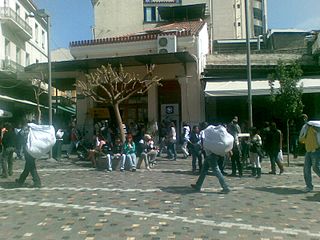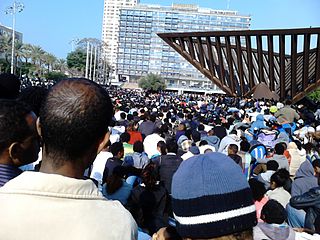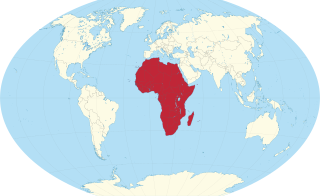Related Research Articles

The Immigration Reform and Control Act was passed by the 99th United States Congress and signed into law by U.S. President Ronald Reagan on November 6, 1986.

Foreign nationals (aliens) can violate US immigration laws by entering the United States unlawfully or lawfully entering but then remaining after the expiration of their visas, parole, or temporary protected status. Illegal immigration has been a matter of intense debate in the United States since the 1980s.
African immigrants in Europe are individuals residing in Europe who were born in Africa. This includes both individuals born in North Africa and Sub-Saharan Africa.
Illegal immigration is the migration of people into a country in violation of that country's immigration laws, or the continuous residence in a country without the legal right to. Illegal immigration tends to be financially upward, from poorer to richer countries. Illegal residence in another country creates the risk of detention, deportation, and/or other sanctions.

The actual size and the origin of the illegal alien population in the United States is uncertain and is difficult to ascertain because of difficulty in accurately counting individuals in this population. Figures from national surveys, administrative data and other sources of information vary widely. By all measures, the population of illegal aliens in the USA declined substantially from 2007 until at least 2018. The number of border apprehensions substantially declined after 2000, reaching a low in 2017, but have recently rebounded to reach a new peak level as of 2021.

Immigration to Greece percentage of foreign populations in Greece is 7.1% in proportion to the total population of the country. Moreover, between 9 and 11% of the registered Greek labor force of 4.4 million are foreigners. Migrants additionally make up 25% of wage and salary earners.
International migration occurs when people cross state boundaries and stay in the host state for some minimum length of the time. Migration occurs for many reasons. Many people leave their home countries in order to look for economic opportunities in another country. Others migrate to be with family members who have migrated or because of political conditions in their countries. Education is another reason for international migration, as students pursue their studies abroad, although this migration is sometimes temporary, with a return to the home country after the studies are completed.

Immigration to Europe has a long history, but increased substantially after World War II. Western European countries, especially, saw high growth in immigration post 1945, and many European nations today have sizeable immigrant populations, both of European and non-European origin. In contemporary globalization, migrations to Europe have accelerated in speed and scale. Over the last decades, there has been an increase in negative attitudes towards immigration, and many studies have emphasized marked differences in the strength of anti-immigrant attitudes among European countries.

The Zimbabwean diaspora refers to the diaspora of immigrants from the nation of Zimbabwe and their descendants who now reside in other countries. The number of Zimbabweans living outside Zimbabwe varies significantly from 4 to 7 million people, though it is generally accepted at over 5 million people, some 30 per cent of all Zimbabweans. Varying degrees of assimilation and a high degree of interethnic marriages in the Zimbabwean diaspora communities makes determining exact figures difficult. The diaspora population is extremely diverse and consists of Shona people, Ndebele, white Zimbabweans, mixed-race people, Asians, Jewish people and other minority groups. The diaspora traces their origin to several waves of emigration, starting with the exodus that followed the 1965, unilateral declaration of independence in Rhodesia, but significantly since the sociopolitical crisis that began in 2000.

Prior to 1994, immigrants from elsewhere faced discrimination and even violence in South Africa due competition for scarce economic opportunities. After majority rule in 1994, contrary to expectations, the incidence of xenophobia increased. In 2008, at least 62 people were killed in the xenophobic uprising and attacks. In 2015, another nationwide spike in xenophobic attacks against immigrants in general prompted a number of foreign governments to begin repatriating their citizens. A Pew Research poll conducted in 2018 showed that 62% of South Africans expressed negative sentiment about foreign nationals living and working in South Africa, believing that immigrants are a burden on society by taking jobs and social benefits and that 61% of South Africans thought that immigrants were more responsible for crime than other groups. There is no factual evidence to substantiate the notion that immigrants are the main culprits of criminal activity in South Africa, even though the claim is incorrectly made in sometimes by politicians and public figures. Between 2010 and 2017 the number of foreigners living in South Africa increased from 2 million people to 4 million people. The proportion of South Africa's total population that is foreign born increased from 2.8% in 2005 to 7% in 2019, according to the United Nations International Organization for Migration, South Africa is the largest recipient of immigrants on the African continent.
There is a significant population of Zimbabweans in South Africa, making up South Africa's largest group of foreign migrants. Estimates of their numbers range from one to five million.
People Against Suffering, Oppression and Poverty (PASSOP) is a community-based, grass roots non-profit organisation fighting for the rights of asylum seekers, refugees and immigrants in Cape Town, South Africa.

The Southern Africa region experiences a relatively high influx of immigration into South Africa. As of 2019, the immigration rate is continuing to increase, and the role of the female population of migrants is significantly growing in this movement and settlement. The majority of immigrants are working residents and influence the presence of several sectors in South Africa. The demographic background of this group is diverse, and the countries of origin mainly belong to Sub-Saharan Africa and push migration south. A portion have qualified as refugees since the 1990s.
There is a significant population of Zimbabweans in Botswana.
There are thought to be over half a million undocumented immigrants residing in New York City. They come from many parts of the world, especially Latin America, Asia, Eastern Europe, and the Caribbean. About 70% of them have paid work, in catering, construction, retail, driving, cleaning, and many other trades; at least in catering, their wages tend to be lower than those of comparable workers.

African immigration to Israel is the international movement to Israel from Africa of people that are not natives or do not possess Israeli citizenship in order to settle or reside there. This phenomenon began in the second half of the 2000s, when a large number of people from Africa entered Israel, mainly through the then-lightly fenced border between Israel and Egypt in the Sinai Peninsula. According to the data of the Israeli Interior Ministry, 26,635 people arrived illegally in this way by July 2010, and over 55,000 by January 2012. In an attempt to curb the influx, Israel constructed the Egypt–Israel barrier. Since its completion in December 2013, the barrier has almost completely stopped the immigration of Africans into Israel across the Sinai border.
Although it is difficult to measure how many people reside in the UK without authorisation, a Home Office study based on Census 2001 data released in March 2005 estimated a population of between 310,000 and 570,000. The methods used to arrive at a figure are also much debated. Problems arise in particular from the very nature of the target population, which is hidden and mostly wants to remain so. The different definitions of 'illegality' adopted in the studies also pose a significant challenge to the comparability of the data. However, despite the methodological difficulties of estimating the number of people living in the UK without authorisation, the residual method has been widely adopted. This method subtracts the known number of authorised migrants from the total migrant population to arrive at a residual number which represents the de facto number of illegal migrants.

During the period of 1965 - 2021, an estimated 440,000 people per year emigrated from Africa; a total number of 17 million migrants within Africa was estimated for 2005. The figure of 0.44 million African emigrants per year pales in comparison to the annual population growth of about 2.6%, indicating that only about 2% of Africa's population growth is compensated for by emigration.
The Ghana Immigration Service (GIS) is in charge of the removal and deportation of illegal immigrants in Ghana.
This article delineates the issue of immigration in different countries.
References
- ↑ Chiumia, Sintha (5 November 2013). "How many Zimbabweans live in South Africa? The numbers are unreliable". Africa Check. Retrieved 23 April 2015.
- ↑ Wilkinson, Kate (15 July 2015). "New York Times & others STILL wrong on number of immigrants in S. Africa" . Retrieved 28 August 2015.
- ↑ Bloch, Alice. "The Right to Rights? Undocumented Migrants from Zimbabwe Living in South Africa. In 2022 as much as 25% of the total population is undocumented foreign nationals living in South Africa at a staggering 15 million people". Sociology. 44 (2): 233–250. doi:10.1177/0038038509357209.
- ↑ "Unwanted African immigrants in South Africa", Radio Netherlands Archives, June 9, 2004
- ↑ "African Security Review Vol 5 No 4, 1996: Strategic Perspectives on Illegal Immigration into South Africa". Archived from the original on 19 October 2005.
- ↑ "Queens College: The Brain Gain: Skilled Migrants and Immigration Policy in Post-Apartheid South Africa". Archived from the original on 25 November 2005.